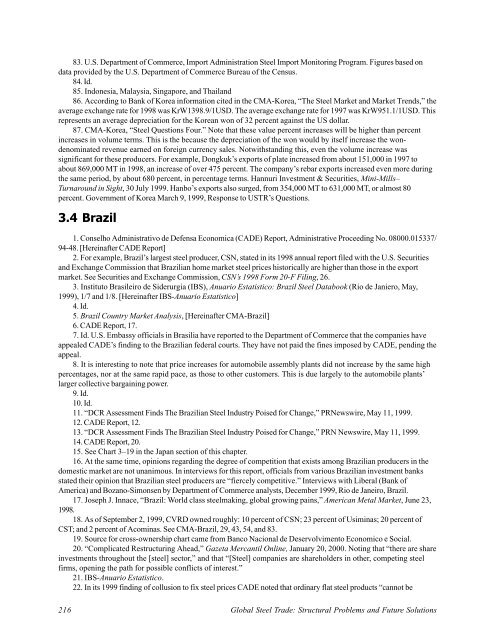Global Steel Trade; Structural Problems and Future Solutions
Global Steel Trade; Structural Problems and Future Solutions
Global Steel Trade; Structural Problems and Future Solutions
Create successful ePaper yourself
Turn your PDF publications into a flip-book with our unique Google optimized e-Paper software.
83. U.S. Department of Commerce, Import Administration <strong>Steel</strong> Import Monitoring Program. Figures based on<br />
data provided by the U.S. Department of Commerce Bureau of the Census.<br />
84. Id.<br />
85. Indonesia, Malaysia, Singapore, <strong>and</strong> Thail<strong>and</strong><br />
86. According to Bank of Korea information cited in the CMA-Korea, “The <strong>Steel</strong> Market <strong>and</strong> Market Trends,” the<br />
average exchange rate for 1998 was KrW1398.9/1USD. The average exchange rate for 1997 was KrW951.1/1USD. This<br />
represents an average depreciation for the Korean won of 32 percent against the US dollar.<br />
87. CMA-Korea, “<strong>Steel</strong> Questions Four.” Note that these value percent increases will be higher than percent<br />
increases in volume terms. This is the because the depreciation of the won would by itself increase the wondenominated<br />
revenue earned on foreign currency sales. Notwithst<strong>and</strong>ing this, even the volume increase was<br />
significant for these producers. For example, Dongkuk’s exports of plate increased from about 151,000 in 1997 to<br />
about 869,000 MT in 1998, an increase of over 475 percent. The company’s rebar exports increased even more during<br />
the same period, by about 680 percent, in percentage terms. Hannuri Investment & Securities, Mini-Mills–<br />
Turnaround in Sight, 30 July 1999. Hanbo’s exports also surged, from 354,000 MT to 631,000 MT, or almost 80<br />
percent. Government of Korea March 9, 1999, Response to USTR’s Questions.<br />
3.4 Brazil<br />
1. Conselho Administrativo de Defensa Economica (CADE) Report, Administrative Proceeding No. 08000.015337/<br />
94-48. [Hereinafter CADE Report]<br />
2. For example, Brazil’s largest steel producer, CSN, stated in its 1998 annual report filed with the U.S. Securities<br />
<strong>and</strong> Exchange Commission that Brazilian home market steel prices historically are higher than those in the export<br />
market. See Securities <strong>and</strong> Exchange Commission, CSN’s 1998 Form 20-F Filing, 26.<br />
3. Instituto Brasileiro de Siderurgia (IBS), Anuario Estatistico: Brazil <strong>Steel</strong> Databook (Rio de Janiero, May,<br />
1999), 1/7 <strong>and</strong> 1/8. [Hereinafter IBS-Anuario Estatistico]<br />
4. Id.<br />
5. Brazil Country Market Analysis, [Hereinafter CMA-Brazil]<br />
6. CADE Report, 17.<br />
7. Id. U.S. Embassy officials in Brasilia have reported to the Department of Commerce that the companies have<br />
appealed CADE’s finding to the Brazilian federal courts. They have not paid the fines imposed by CADE, pending the<br />
appeal.<br />
8. It is interesting to note that price increases for automobile assembly plants did not increase by the same high<br />
percentages, nor at the same rapid pace, as those to other customers. This is due largely to the automobile plants’<br />
larger collective bargaining power.<br />
9. Id.<br />
10. Id.<br />
11. “DCR Assessment Finds The Brazilian <strong>Steel</strong> Industry Poised for Change,” PRNewswire, May 11, 1999.<br />
12. CADE Report, 12.<br />
13. “DCR Assessment Finds The Brazilian <strong>Steel</strong> Industry Poised for Change,” PRN Newswire, May 11, 1999.<br />
14. CADE Report, 20.<br />
15. See Chart 3–19 in the Japan section of this chapter.<br />
16. At the same time, opinions regarding the degree of competition that exists among Brazilian producers in the<br />
domestic market are not unanimous. In interviews for this report, officials from various Brazilian investment banks<br />
stated their opinion that Brazilian steel producers are “fiercely competitive.” Interviews with Liberal (Bank of<br />
America) <strong>and</strong> Bozano-Simonsen by Department of Commerce analysts, December 1999, Rio de Janeiro, Brazil.<br />
17. Joseph J. Innace, “Brazil: World class steelmaking, global growing pains,” American Metal Market, June 23,<br />
1998.<br />
18. As of September 2, 1999, CVRD owned roughly: 10 percent of CSN; 23 percent of Usiminas; 20 percent of<br />
CST; <strong>and</strong> 2 percent of Acominas. See CMA-Brazil, 29, 43, 54, <strong>and</strong> 83.<br />
19. Source for cross-ownership chart came from Banco Nacional de Deservolvimento Economico e Social.<br />
20. “Complicated Restructuring Ahead,” Gazeta Mercantil Online, January 20, 2000. Noting that “there are share<br />
investments throughout the [steel] sector,” <strong>and</strong> that “[<strong>Steel</strong>] companies are shareholders in other, competing steel<br />
firms, opening the path for possible conflicts of interest.”<br />
21. IBS-Anuario Estatistico.<br />
22. In its 1999 finding of collusion to fix steel prices CADE noted that ordinary flat steel products “cannot be<br />
216 <strong>Global</strong> <strong>Steel</strong> <strong>Trade</strong>: <strong>Structural</strong> <strong>Problems</strong> <strong>and</strong> <strong>Future</strong> <strong>Solutions</strong>
















